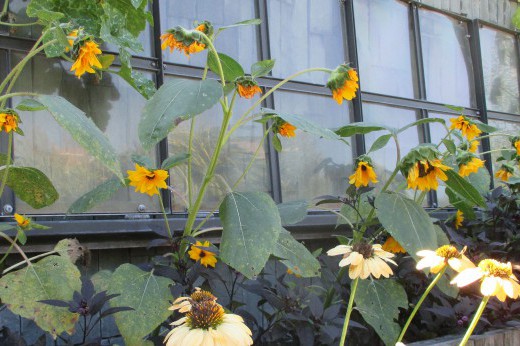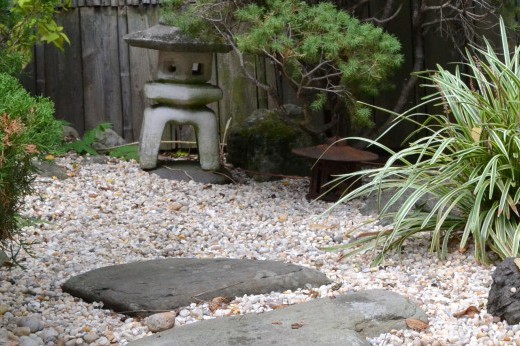Fortunate are gardeners in mild-winter regions, where container gardening is a year-round pleasure without the threat of shattered pots and frozen plants familiar to many of us. Compared with their garden-grown counterparts, container-grown plants are at a severe disadvantage when cold weather arrives. Though hardy plants have developed foliage, stems, and branches that can withstand very low temperatures, their roots are far more sensitive and vulnerable to freezing.
When planting in containers, even choosing plants hardy in your region is no guarantee that they will survive the winter. Many experts suggest that to better the odds of a plant's survival, choose one marked as hardy in two zones colder than your area. For example, if you garden in Zone 7, choose perennials, trees, and shrubs marked hardy to Zone 5 to increase the chance that the plants will survive the winter. When possible, use large containers for plants that must remain outdoors—the greater volume of soil surrounding the plants will provide increased insulation around the roots.
Thinking Regionally
Luckily for gardeners in mild-winter regions (the warmer parts of Zone 8 and south), container-grown plants require little or no winterizing beyond moving pots to more sheltered locations and perhaps covering them with frost blankets when freezing temperatures are expected.
In colder regions, where freezing temperatures are the norm at the height of winter, gardeners must protect plants from both the cold and the wind using a range of techniques. Overwintering container-grown plants outdoors is extremely challenging in the coldest regions of the country (Zone 4 and colder), where it's best to grow annuals and perennials for one short season of color.
In all but the mild-winter regions, potted plants grown on terraces and rooftops, where they will be exposed to chilling winds, should be moved to a sheltered location, such as close to a building or near a pergola or other structure, away from high winds and winter sun. When possible, group pots together, placing the most cold-sensitive plants at the center of the group, so they receive additional protection from the hardier plants.
Container Care
The first step for winterizing the container garden is to clean and tuck away any empty pots. Store clay and terra-cotta pots upside down or on their sides in a dry place. Because they are made of porous clays, most terra-cotta pots are not suitable for leaving outside in freezing temperatures, which can cause them to crack or shatter. If you must leave terra-cotta pots outdoors, choose ones made of special clay that tolerates freezes (like Impruneta, for example). Glazed pots, which are usually fired at higher temperatures, tend to withstand freezing better than terra-cotta.
To protect planted terra-cotta and glazed containers left outdoors, wrap the sides of the pots with layers of bubble wrap or burlap covered with plastic wrap to prevent them from absorbing additional moisture once the plants go dormant and their water requirements are minimal. (Wrap pots containing evergreen plants in plastic after the first hard frost.) If you have empty concrete, cement, or clay containers that are too large to move, clean them as much as possible and cover them with lids or plastic sheeting to prevent water from collecting inside, freezing, and cracking the pots. Sturdy plastic and fiberglass pots are ideal for leaving outdoors, although some plastic pots may crack if the soil inside expands as it freezes. Wooden containers made of durable hardwoods are also suitable and will age gracefully over time.
Preparing Plants for Winter
Many plants prepare themselves for winter by taking cues from the environment: As days shorten and temperatures drop, many temperate plants enter the first phase of dormancy by slowing growth. To help prepare your plants for winter, stop fertilizing them by midsummer to reduce tender new growth that is vulnerable to frost, but do continue watering regularly through fall. Evergreens, especially broad-leaved evergreens, which are particularly vulnerable to desiccating winter winds, should be watered well until the first hard frost.
In fall, when nights begin to get chilly, take cuttings of tender perennials like coleus, impatiens, and geraniums to overwinter indoors. Before the first frost, move pots of annuals, tender perennials, and tropicals indoors into a bright window. Move half-hardy perennials to a cool garage or basement, where they will drop their leaves and go dormant. Cut hardy perennials that will remain outdoors back to four to five inches above the soil line once their leaves drop after the first hard frost.
Many perennials, trees, and shrubs must have a dormancy or chill period if they are to flower and fruit the following season, and cannot be moved into the house. Leave these plants outdoors and protect them using some of the techniques described in the next section. In regions with freezing winter temperatures, move them before the first hard frost to a location such an unheated garage or basement that remains about 30 to 40° F. (Although the plants will be dormant, they will benefit from some light). Reduce watering to about once a month or when soil becomes very dry; do not allow the soil to become completely dry. Plants kept in cool indoor locations tend to break dormancy earlier in the season than their outdoor counterparts; however, they should be hardened off and moved outdoors only after the danger of frost has passed.
Woody plants that must remain outdoors have a few special requirements. To prevent the branches of deciduous trees and shrubs from whipping around and breaking in winter, loosely tie branches together after the leaves have dropped. Evergreen woody plants, particularly vulnerable to desiccating winds, can be sprayed with an antidesiccant, also known as antitranspirant, and may need to be protected against harsh winter sun with burlap screens.
Winter Protection Techniques
When left outdoors, perennials, trees, and shrubs are not only subject to extreme cold and wind, but are also vulnerable to cycles of freezing and thawing that can cause heaving (plants are literally heaved out of the soil as it expands and contracts). To reduce heaving and root damage, try to re-create the naturally insulating effects of the earth. If possible, find an area in the garden that you can dig up, and sink the pots into the ground so their roots will be insulated by the surrounding soil; then mulch heavily with straw, shredded bark, or leaves as you would other plants. If this is not possible, heavily mulching container-grown plants with straw, leaves, hay, or shredded bark will provide significant protection. Some gardeners take the extra precaution of wrapping the sides of the container with several layers of bubble wrap (to protect both delicate containers and root systems), and then mulching.
When convenient, cluster planters in a more sheltered location, such as under an eave, next to your house, or near a south-facing wall, and then mulch. Transfer small containers into a cold frame packed with sand or straw. (To create a temporary cold frame, arrange bales of hay to form four walls and top them with an old window, heavy-duty clear plastic, or a plexiglass lid.)
In open, windy areas, creating a burlap screen or windbreak provides additional protection, particularly for woody plants and shrubby perennials. Young trees and evergreen woodies, like boxwoods, which are susceptible to sunscald, will especially benefit from a burlap screen. To create a screen, pound several stakes around the plant's perimeter, and staple three-foot-wide burlap to the stakes, forming a fence around the plant. Alternatively, create a tall cage of chicken wire around the planter, and fill this with leaves or hay to provide insulation. Group smaller plants together before surrounding them with burlap or chicken wire.
The most extreme method, and one that is recommended for half-hardy plants like fuchsias and figs grown outside of their hardiness ranges, is trenching. This requires enough garden space to dig a 14- to 16-inch-deep trench, in which the plant—pot and all—can be laid down on its side and lightly re-covered with soil. The plant's branches and stems are covered with loose mulch and held in place with burlap for the season.
Regardless of which method you use, at the first signs of growth in spring, remove the heavy dressings from every planting and—if you protected them properly—you'll find them rejuvenated by their winter slumber.



